Landscaping of the household site is a difficult thing that requires considerable time and strength. But there are unpretentious flowers that will greatly decorate any household plot. An example can be a liatris plant - very bright, a gripful culture, called the "Lazy's" people for ease of care and the lack of special requirements for the landing and soil.
What is a liatrix plant?
Unusual Valtrice Break-shaped inflorescences can become a highlight of any garden, outwardly reminding huge candles. The mechanism of their flowering is significantly different from similar plants - buds are disclosed gradually, moving downwards. Licarisses are grown in almost all regions of the country, they are distinguished by their resistance to diseases and unpretentiousness.
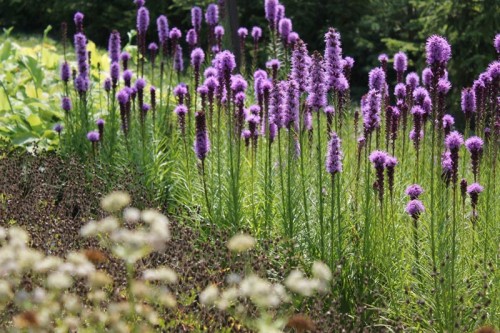
Origin of unusual flowers
Liatris (from Latin Liatris) is a representative of many years of herbaceous plants belonging to the Astrov family (the genus of complex color). Like other astera representatives, culture is distinguished by a disco-shaped form of a flower head and several shooting boots. It is traced a strong similarity with Garberia, with the exception of the shape of the shrub of the last and karyotype.
In nature, liatrix grow in Mexico, Bahamas and North America. There are about 20 of their species in natural habitat conditions. In the title of the plant, 2 words of Greek origin are combined, which are translated as a "doctor" and "smooth." The people of liatresses are called "deer tongue", the "blazing star" and "funny pieces".
They obtained its propagation as a garden crop due to the excellent decorative characteristics of inflorescences and a sophisticated smell, combining the notes of freshly adhesive hay and light flavor of Vanilla. For a person, such a smell is pleasant, which you can not say about the moths: she does not tolerate it. Just just one liatrix stem for a whole closet for clothes to completely get rid of the pest of woolen things for half a year.
Even dried or cut plant retains a thin exquisite fragrance for a very long time. Its flowers are popular in perfumery, they are used to create spirits with a gentle pleasant smell. Enjoy the success and essential oil of liatris.
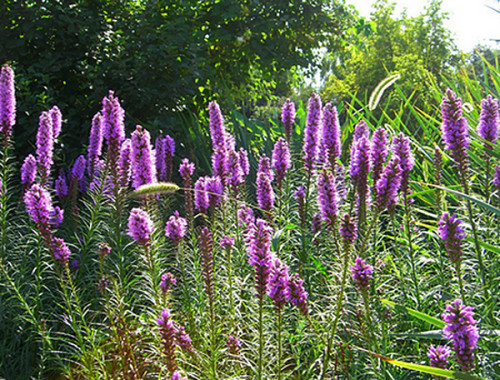
Description of liatrix - the most unpretentious culture
Liatriras refer to perennial plants that experience the winter time in the form of clubnellukovs forming rhizome. Their standing stalks can be simple or branched, but always densely covered with simple linear form leaves, pointed to the outer edge. Depending on the variety there is another or mutive landing of pagons.
The leaves have a rich green color, saved unchanged to the autumn itself. In the period of fondation, the foliage turns into a bright carpet of the bronze color, which can be decorating the autumn garden. Liatris shrubs in height can be from 30 cm to 2 m. Some of its varieties are used as feed for larvae of scratched.
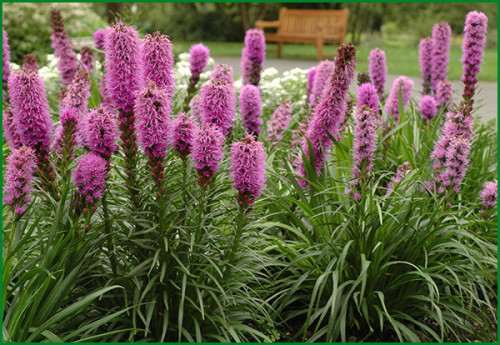
Tubular liatrix flowers are assembled in baskets, of which co-shaped or creeping inflorescences are formed, reaching a length of up to 0.5 m. The plant is characterized by a special aesthetic forms resembling a candle. Blooming liatris produces buds resembling arrows, creating the effect of a tanning candle. A variety of shades of the plant is the widest: white, red, pink, purple, purple.
The rhizome of the plant has the form of tuberukukovs, which are connected to each other with subtle processes. It is usually located almost at the surface of the earth. Liatris Fruits are represented by staminations with a ribbed appropriate shape.
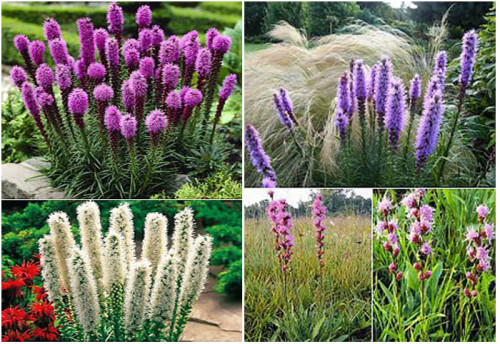
A unique plant besides excellent aesthetic characteristics and gentle aroma, has healing properties. His decoctions from a long time fought with different diseases, and the cut-off jams were applied on the affected snake place. The infusion of liatris helps to cope with the renal diseases, they can, with a cold, rinse the throat or make the rods on the wounds for the speedy healing.
Culture is widely used and as a panacea from malaria, a diuretic, a cure for a number of venereal diseases. Cosmetologists are used by liatryis beam, possessing an excellent tonic effect.
Features of blossom of bright "candles"
Liatris blooms for a long time and very unusual. Its tubular buds bloom in the direction from top to bottom, forming fluffy inflorescences. It is noteworthy that a flowing plant begins only after full blooming of the bloody. Liatris is rich in a wide palette of paints, but the former varieties are considered rarely encountered.
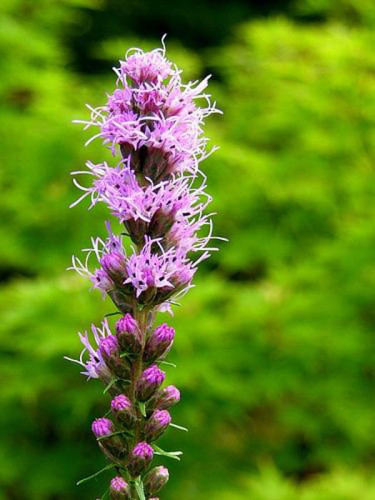
The uniqueness of the plant is manifested in combination of a variety of characteristics that are found in other cultures separately: a thin fragrance, the originality of flowering, unpretentiousness, therapeutic properties. The period of his flowering falls for the summer. Usually liatrisia begin to bloom in the first half of July and end the end of August.
Liarmis varieties
In the culture, 3 main types of plants are common:
- spicate;
- filmy;
- rough.
Liatris Karoskova (from Latin Liatris Spicata) occurred from the southeastern lands of the northern part of America. Its thickly covered with simple leaves of the stems are not exceeded in a height of 1 m. The inflorescences of the plant are represented by small baskets consisting of 10-13 tubular buds. All of them form co-shaped blossoms up to 40 cm long. The flowering period of sparkling liatris begins at the end of June and continues approximately 30-40 days. Upon its completion, a large number of seeds appear.
The spikel liatris was bred back in 1732. The most popular varieties are:
- Floristan Weib - Gives White Flowers;
- Floristan Violett (Floristan Violett) - purple;
- Kobold (Kobold) - pink or pink-purple;
- Silver Tips - purple;
- Pikador - purple;
- Blue Bird is azure.
For the landing of liatris sparkling, the usual primer from the garden and the plot completely lit by the sun is fully lit. Such plants are often used to attract butterflies and birds.
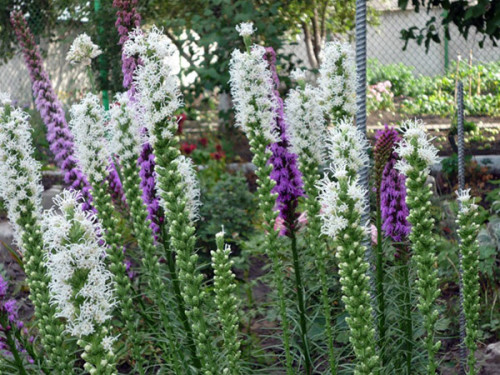
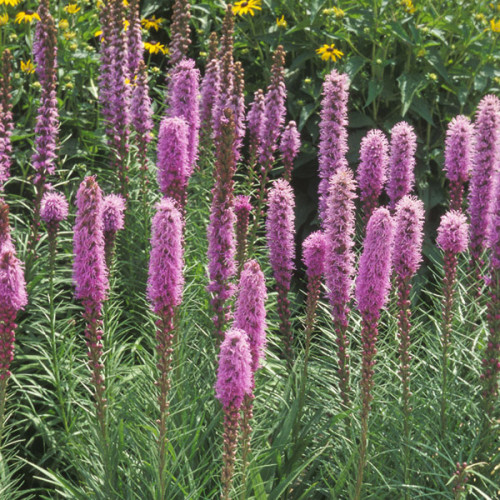
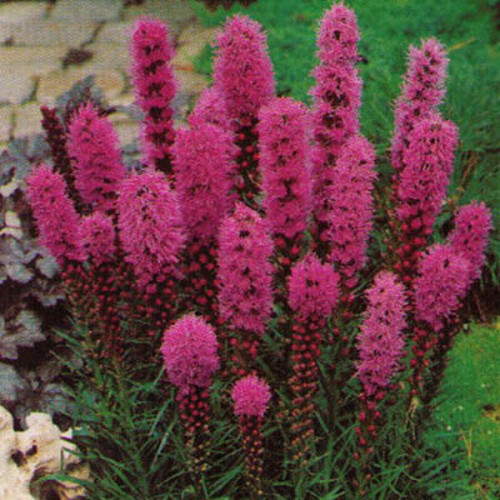
A rare variety of hollow liatris - Floristan Weib, which is characterized by the past coloring inflorescences. Its leaves are small in comparison with other varieties, but this feature is filled with their number. The height stem usually does not exceed 20 cm, and small flowers form inflorescences of 60 cm.
Such a kind of liatris is considered a good honey. A shrub during flowering period grows up to 40 cm in width. Fruits ribbed, covered with small hair, and the seeds themselves have an oblong shape. White liatris resistant to low temperatures, so it can be winter without additional shelters.

The dwarf grade of spiker culture - Kobold, not exceeding the elevation of 50 cm, the best grows in sunny sites or in a half. A small shrub has a bright pink-lilac coloring, its beads in the form of feathers are located on neat stalks. The plant blooms abundantly, long retains aesthetic appearance with green leaves, which remain attractive even after squeezing.
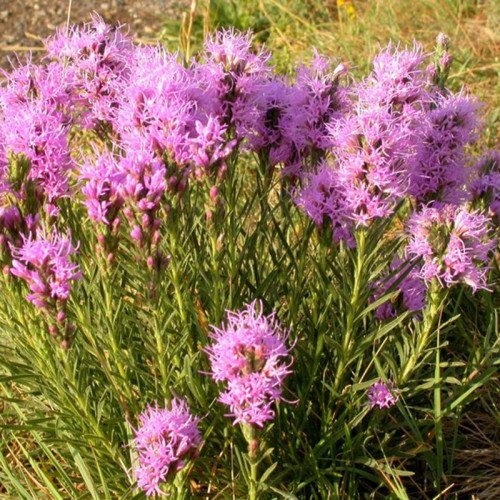

Liatris Film (from Latin Liatris Scariosa) has wider leaves than other representatives of culture. In the width, they reach 3 cm. The inflorescence of the plant is usually a dark pink-lilac shade, and the bloom in height is nearer nearing 1 m.
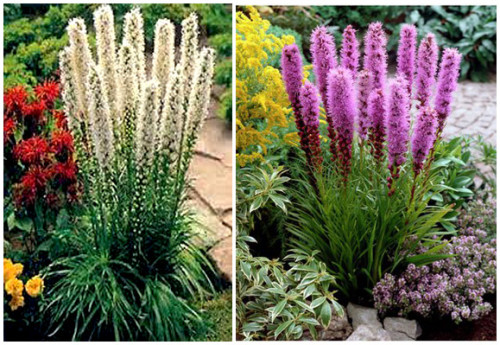
Liatris Grouse (from Latin Liatris Aspera) - rarely meeting a plant variety, which is characterized by the highest height of the stem (about 2 m). Flowers of such a small plant, have a purple-pink color. They grow thick and form long fluffy inflorescences.
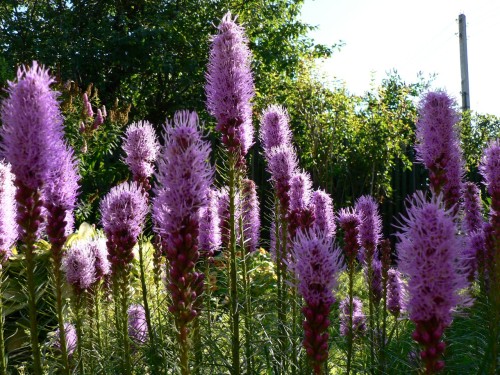
Using liatrix in garden decoration
Popular use of liatrix in the landscape design of garden sites in a single landing of a bush or in combination with different colors - flocks, gypsophila, Armeria, Verbena, Brunner. Culture can be grown for cutting, its flowers remain fresh up to 10 days, and after drying it is used to form winter bouquets.
Liatris is well combined with flowers having an openwork structure of the bush and the inflorescence of the rounded shape. Successful will be a neighborhood with field plants. In solo landing, liatris is used as longitudinal plantings along the line of the Sun, for example, near the fence, small buildings, flower complex, architectural design elements.
Plant is often used in complex flower beds-mixboarders or to decorate the site at the foot of the Alpine slide. On the flower beds it is placed in a circle, creating a large, beautiful bush. In rocaries, liatris serves as a special minaret, which is complemented by fountain, stones, other flowers (wide-sized ferns, hydrangea, floccam, etc.). A wide variety of design solutions is represented in the photo of liatris in different combinations.

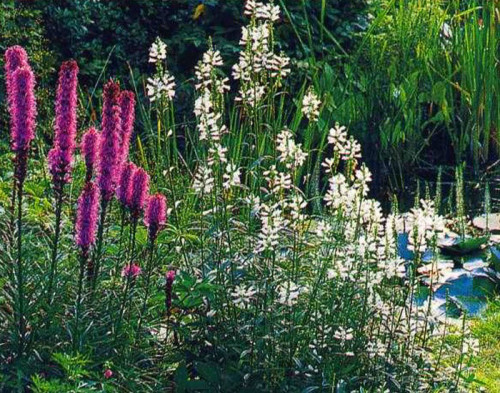
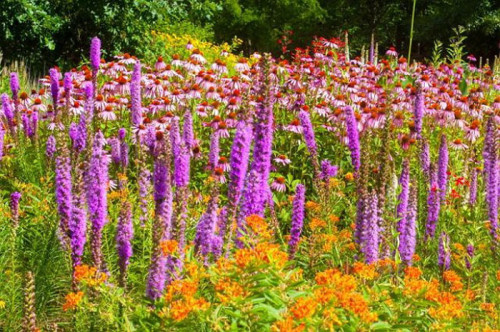

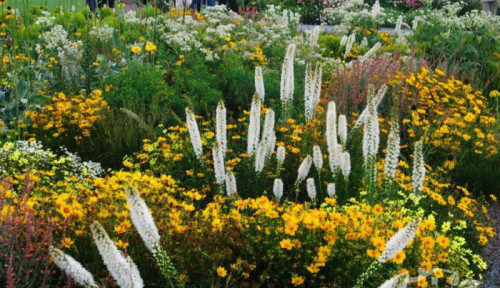
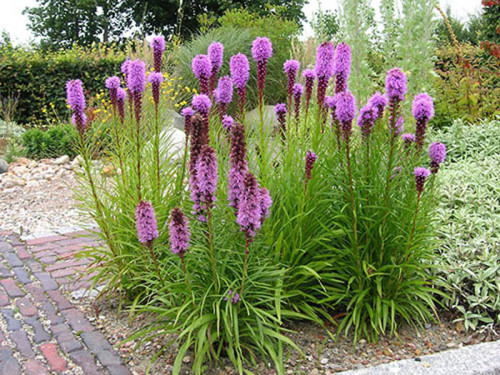
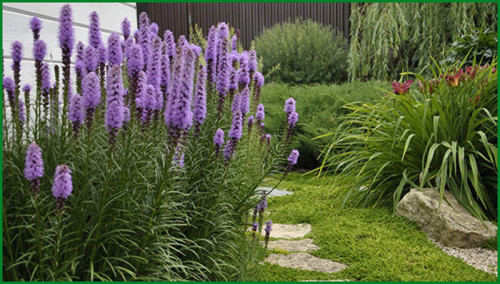
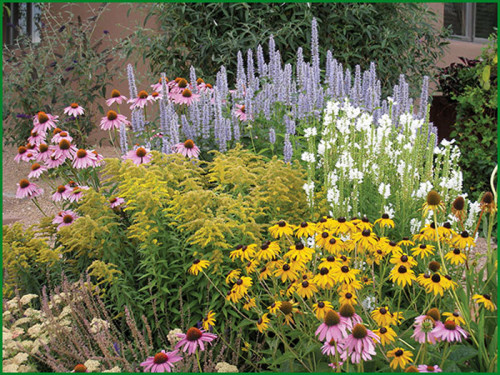
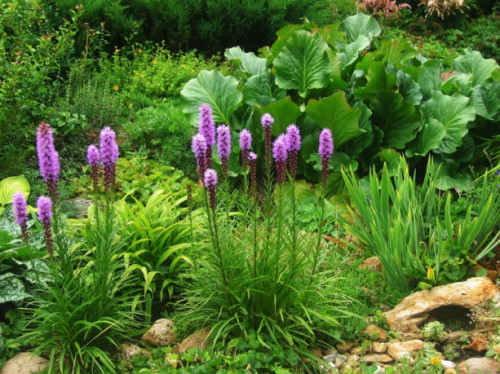
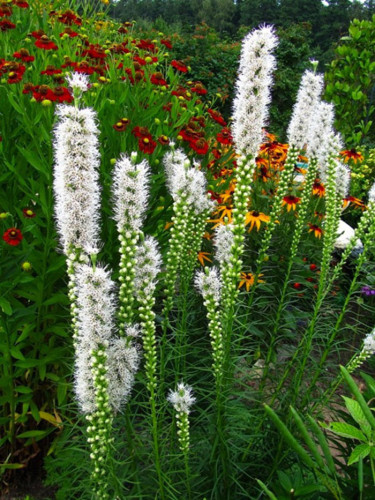
Growing and reproduction of liatrix
The plant can grow in several ways: from seeds, clubnellukovs or rhizomes. The planting material is acquired in nurseries or specialized stores, and also prepared independently. The cultivation of liatris always begins with the choice of high-quality source material and creating conditions for landing.
The advantage of the plant is the possibility of flowering in the first year after disembarking into open ground. The appearance of the first buds, bright colors, brilliant healthy leaves will not require many years of waiting.
When and where to plant?
Before planting plants, it is important to determine the place where the most comfortable conditions will be for its growth and development. The best option for liatrix will be an open sunny plot. Straight rays will not harm the plant and high temperatures it transfers well. But this will not tell about the cold and damp, which can lead to the full liatrix death.
Do not forget about the observance of a sufficient distance between the plants, the distance should be at least 25-30 cm. Despite the love for sunlight, the flower is able to withstand a light shading. Liatris in open soil is planted in autumn or early spring. In the first case, it is important to finish all the events a month before the establishment of permanent snow cover. If planting plants in spring, then it is better to do it as early as possible.
The liatrix grown in suitable conditions is well growed, creating beautiful bushes with a young sworn. In height, they sometimes reach 2 m, pleaseing the eye with luxurious inflorescences. If the conditions are not so favorable, the plant will be smaller in size, but it does not lose the aesthetics.
Features of the preparation of soil
Liatris will feel comfortable in loose, well-drained land rich in trace elements and useful substances. Absolutely will not suit raw, heavy substrates, clay lands, which are often found in natives and other downstream relief. For the plant, the soil with a neutral pH reaction is suitable or a bit scaled.
It is afraid of liatris of the close location of groundwater and frequent, abundant irrigation. Its root system is almost on the surface and can be rotated, which will certainly lead to the death of the plant. The best option for liatrix will be dry soil and lack of precipitation.
Growing Plants from Seeds
The reproduction of liatris seeds can occur with a decide or reckless way. But spending time and strength to grow seedlings does not make sense, since the culture is a rack to low temperatures and unpretentious to the conditions of cultivation.
Liatris seeds are made late autumn or as early as possible in the spring directly in the open ground. The plant is resistant to the frost, but it is recommended to soak the material in a solution of humate or mangartee for 12 hours immediately before landing. Usually before the appearance of the first sprouts, it takes from 2 weeks to 1.5 months. To ensure the best germination, seeds can be about 30-45 days to store them in a cold and wet place.
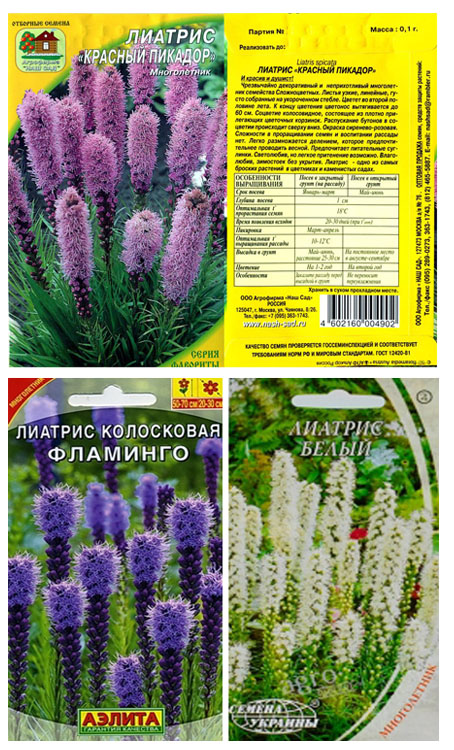
The land under the landing is pre-pumpped with an organica: for each site in size in 1 m 2 Motion and mineral fertilizers are made. For seeds are made in shallow grooves, it is enough to 1-1.5 cm. The planting material is evenly distributed over the well, it is saturated with soil and watering.
It is important to take into account the fact that when planting liatris from seeds, abundant bloom and the full development of the plant is worth waiting for only 2-3 years after disembarkation. Also possible abundant self-sifts of adult flowers in the fall, then the spring is enough just to proper shoots. The reproduction of liatris seeds does not always give a guarantee of preserving genetic features, which is particularly clearly visible when growing hybrids.
Liatris reproduction by bush
The best and easiest way to reproduce the plant is the division of the bush. Mature flower is simply divided into several pieces. It is important to ensure that all parts of the plant have root cervous and tuber. The land plot is pre-drunk with humid and mineral fertilizers.
In the prepared ground, wells are made, the depth of which depends on the root size and is usually about 20 cm. Separated parts of the bushes are planted:
- the root of the plant is placed in the hole;
- a small amount of humus is shoved on the bottom;
- everything falls asleep good land;
- around the plant is laid out a layer of mulch.
Liatris planted at a distance of 25-30 cm from each other, so that the new bushes are not intertwined. This method of breeding can be used once for 4 years and carry out a transplantation in early spring or late autumn. This will allow not only to multiply the plant, but also get flowering bushes from the first year.
Culture of culture from rhizomes
The underground part of the Litris is represented by the rhizome, formed by the tubers. The latter are connected to each other. Each tuber in shape resembles a stubborn bulb. The separation of the root into parts does not harm the plant and allows you to grow new bushes that bloom in the first year. Therefore, liatrix reproduction in this way is preferable to growing from seeds.
Rhizomes are digged in autumn, after dried up the green mass. The tubers are cleaned from the ground, dried and sorted. It is important to choose tubers at least 2 cm. If there are no such, then you can buy landing material in a specialized store. Small tubers can be planted for growing.
Preparing for planting a club, it is necessary to inspect them on the subject of shutters or mechanical damage. It has the importance and correctness of the root location: the depression located on it should be directed towards the surface of the Earth. For planting, a fertilized soil is needed, in which the holes are made at a depth of 8-10 cm. The distance should be 25-30 cm. Regardless of the process of cultivation, adult plants are preferably digging every 3-4 years and split on the tubers. The best time for the procedure is May or August.
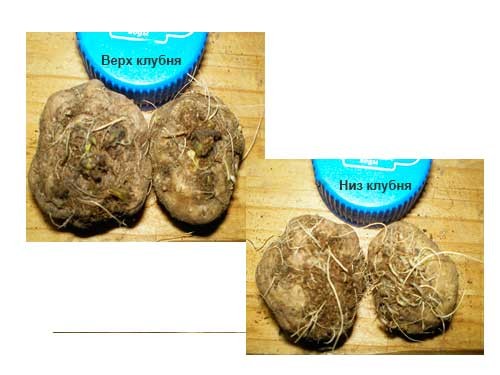
Safe wintering plants
When the green mass of the plant boosts and turns, the entire above-ground part is cut, and the surface of the earth is mounted 10 - 15 cm layer of peat, dry leaves, compost or husknik. It is not suitable for shelting straw, since it can nest rodents that feed on the root of the plant in winter. Under the conditions of soft winter, liatris can be good and without mulching.
Features of liatris care
Liarmis care can be considered a rather unpretentious plant, but there is still its own characteristics.
- Watering the plants is necessary, it can be well transferred to drought. But the wasting moisture liatris does not like, so in the rain period it is worth organizing an artificial drainage system so that the water does not accumulate from the roots. For the plant, there will be enough moisture from the rain if the precipitation will be at least once for 7 days.
- It is unpretentious to the temperature line of liatris, it perfectly transfers freezing and heat. Special attention should be paid to the soil to mulch the plant and raise the land to it by analogy with potatoes. It should be engaged in the soil with extreme caution, its muscles are located close to the surface and may be damaged, which damages the flower. Instead, the Earth should be mulched with organic fertilizer or fertile soil. This will protect the root system of the plant and facilitate care for it, freeing from the need to regularly remove weeds.
- Liatris needs feeding: nitrogen fertilizers are suitable for spring, for summer - phosphate-potash. High colors sometimes require tapping to the support to prevent the plant to prevent. Faded inflorescences are removed, which prevents the loss of a decorative appearance by a plant even after biting. To prepare liatris to wintering and strengthening his tubers, at the end of the autumn it is worth making nitrogen fertilizers. Recognize the lack of these substances in the plant is very simple: its green mass begins to be substantially lit.
Pests and liatrix diseases
Laitrice landing and care are pretty simple, do not require special knowledge and effort. He is stable for diseases, but may be damaged by snails or bear. To combat them, a simple popular method is well suited: a bottle of beer (approximately 100 ml) is laughed in the ground at an angle of 45 ° so that its neck is in a small well, below 2-3 cm on the surface level. Snails and Medveda will slip on the smell of beer and trap. The disadvantage of the method is the need to regular beer update in the bait.
From the re-fulfillment of moisture liatris can be rotated. To save the plant, it is worth cropping all the rotting pains above the ground and treat it with fungicide. In the case when the disease is caused by its placement in the heavy ground or proximity of groundwater, it is worth thinking about changing the site.

The comic name of liatris is the "Lazy Flower", associated with its resistance to the habitat and the weak exposure of diseases and pests. All types of plants are good honey. Liatris rightfully may take a special place in the garden of an experienced flower plant and a beginner or an amateur.

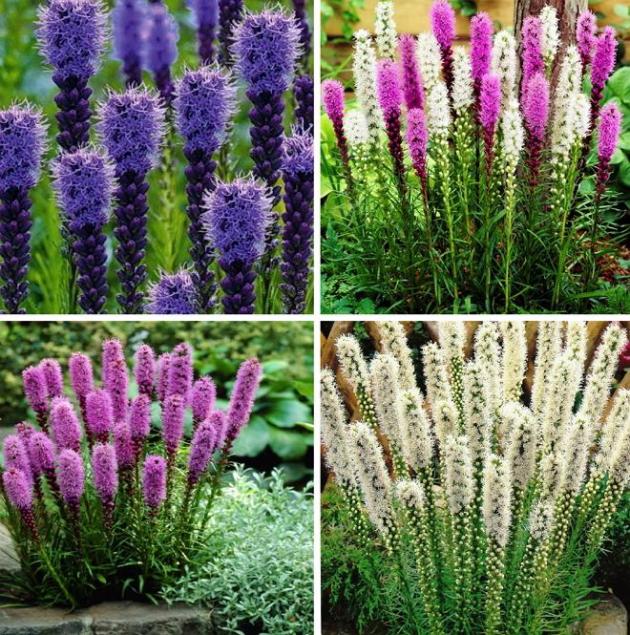












 Start a discussion ...
Start a discussion ...